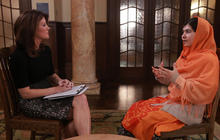Where in the world is it hardest to be a girl?
The United States ranks behind countries including Algeria and Kazakhstan in a new report that rates the best and worst countries in the world to be a girl.
The report, released today by Save the Children in conjunction with International Day of the Girl, looked at factors including schooling, teen pregnancy, child marriage, maternal deaths and number of female representatives in national government to determine the ranking.
The U.S. came in 32nd of the 144 countries in the rankings.
Nations at the bottom of the index include Niger, Chad, Central African Republic, Mali and Somalia, while countries at the top include Sweden, Finland, Norway, Netherlands and Belgium.
While the United States is one of the richest nations in the world, it is not keeping up when it comes to the well-being of its girls, says Carolyn Miles, president and CEO of Save the Children.
“The U.S. does not fare well in the Girls’ Opportunity Index,” she told CBS News. “It has the world’s biggest economy but is not keeping in the size and scale and wealth of the country.”
A few different issues played a role in determining the U.S.’s position on the list. These include relatively high teen pregnancy and maternal mortality rates. For example, 14 women died per 100,000 live births in the United States in 2015. That’s a similar number to Uruguay and Lebanon and far higher than the three deaths per 100,000 in Poland, Greece, and Finland.
Another reason is poor female representation in government. Currently, only 19 percent of members of Congress are women. “That’s quite a small percentage when you look at the women in the highest levels of government in other countries,” Miles said.
The report comes four weeks before Election Day, when Hillary Clinton is running to be the first female president in U.S. history. Miles believes it could make more than just a symbolic difference.
“The reason that we measured that as part of the index is that we believe that a woman in positions of power in government are willing to make policies that are beneficial to women or girls and I certainly think that in the United States that will be the case,” Miles said. “The other reason for using that as an indicator, which is incredibly important in many countries including the U.S. is to show girls strong role models.”
The report includes several other striking facts, including statistics on child marriage. According to the data, one girl under 15 is married every seven seconds ,and girls as young as 10 are marrying – to much older men – in countries like Afghanistan, Yemen, India and Somalia.
“It’s the things that happen after when a girl gets married that young. When a girl gets married at 13 or 14, 99 percent of them will drop out of school then,” Miles said. “They are very likely to have children shortly after they get married, so it’s children having children and that in turn starts this whole cycle because young girls are going to have higher mortality rates, will be more likely to have children who are underweight and to also die before the age of 5.”

Malala: Fearless teen leads fight for global education
One year ago, Malala Yousafzai was recovering from an attempt on her life by the Taliban. Now, she is among the most famous girls in the world as…
The report outlines three major strategies governments can take in order to ensure all girls have the chance to “live, thrive and reach their fullest potential in life.” These include adequate funding and spending on girls to ensure their minimum financial security and that they have access to health, nutrition and education services; guaranteeing the equal rights of all girls by challenging discriminatory laws, policies, norms and practices and ensuring all births and marriages are registered so girls can claim their rights; and guaranteeing all governance is inclusive, gender sensitive, transparent and accountable to all girls.
On a more personal level, families can take steps to ensure that their girls are valued.
In the U.S., Miles said parents can talk to their children about global gender inequalities, but also take steps to help ensure their equal treatment at home.
“Thinking about how we talk to our girls, what our expectations are for them is really important for parents,” she said. “We all probably have some inherent differences in the way we bring up our boys versus our girls and thinking about that and making sure families understand that girls do have equal value is really important.”